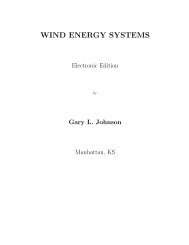Small Scale Foundries for Developing Published by: Intermediate ...
Small Scale Foundries for Developing Published by: Intermediate ...
Small Scale Foundries for Developing Published by: Intermediate ...
Create successful ePaper yourself
Turn your PDF publications into a flip-book with our unique Google optimized e-Paper software.
patterns, using three or more section moulds<br />
to avoid the need <strong>for</strong> cores, or sometimes<br />
using templates or sectional patterns to<br />
make uni<strong>for</strong>m mould shapes <strong>by</strong> hand.<br />
The making of complex castings <strong>by</strong> hand<br />
moulding requires two or more years of<br />
training; however simple hand moulded<br />
castings can be produced after a few weeks’<br />
experience.<br />
The hand moulder’s tools include a<br />
rammer, shovel, sieve, a fine trowel <strong>for</strong> cutting<br />
the sand, vent wires, lengths of tube <strong>for</strong><br />
cutting pouring holes etc. Dry powder (<strong>for</strong><br />
example powdered bone dust) is dusted on<br />
patterns and joint surfaces to stop the<br />
moulding sand sticking and not separating<br />
cleanly.<br />
The moulder must also make the runner<br />
channels in the mould when these are not<br />
part of the pattern equipment. Loose<br />
wooden pieces should be used to mould the<br />
ingates into the casting cavity. The runner<br />
channels and feeders may be cut with a<br />
trowel, or moulded from standard loose<br />
pieces kept with the moulder’s equipment.<br />
A cut sand surface wi!l not be as smooth as a<br />
moulded surface, and even if it is smoothed<br />
with the trowel may entail the risk of producing<br />
sand inclusions in castings.<br />
Machine Moulding<br />
Mechanised casting production needs<br />
moulding machines Moulding machines<br />
may jolt sand into position or squeeze the<br />
sand round the pattern. Both methods are<br />
often combined in one machine.<br />
Most simple squeeze machines are not<br />
useful <strong>for</strong> moulds in which each half is more<br />
than about 150-200 cm deep although<br />
special high pressure hydraulic machines<br />
have been designed <strong>for</strong> deeper moulds.<br />
Usually moulding machines are instalied<br />
in pairs, one to make top half mouids and<br />
one to make bottom half moulds. There are<br />
types of moulding machines which can produce<br />
complete moulds on one machine. It is<br />
also possible to use one machine to make<br />
bottom half moulds, and then later to use<br />
the same machine with the other half pattern<br />
18<br />
to make the top half moulds.<br />
Moulding machines usually require a<br />
supply of compressed air (e.g. at 6 atmospheres),<br />
although some types operate with<br />
self-contained hydrau!ic pumps and require<br />
only to be connected to an electrical supply.<br />
<strong>Small</strong> moulds can be made on simple<br />
moulding machines, in which the squeeze<br />
pressure is applied <strong>by</strong> hand with a long lever,<br />
using neither pneumatic nor hydraulic<br />
power assistance.<br />
Even the simplest moulding machines<br />
provide a mechanised means of stripping the<br />
mould from the pattern and if necessary of<br />
turning the mould over during production.<br />
Although special purpose moulding<br />
machines can be very complex pieces of<br />
equipment, a well equipped workshop<br />
should be able (with some assistance at the<br />
design stage) to produce a simple machine<br />
from structural steel, iron castings, and<br />
hydraulic or pneumatic cylinders and<br />
valves.<br />
One special type of moulding machine is<br />
the sand slinger. Sand slingers contain<br />
impellors with spinning blades to hurl the<br />
sand at high speed into the moulds. Sand<br />
slingers are expensive machines, used <strong>for</strong><br />
large castings, and not usually suitable <strong>for</strong><br />
small scale foundries.<br />
It is possible to purchase automatic<br />
moulding machines which produce very<br />
high quality moulds at extremely high rates<br />
- several hundred complete moulds per<br />
hour. Such a moulding machine on its own<br />
has no value; it must <strong>for</strong>m part of a complete<br />
mechanised foundry system, including sand<br />
preparation equipment and mould and sand<br />
handling conveyors. The maintenance and<br />
the capital costs of such equipment are high<br />
and are only justified when there is a very<br />
large and assured market <strong>for</strong> mass production<br />
of castings.<br />
Even simple moulding machines are only<br />
suitable <strong>for</strong> repetition production of batches<br />
of 20 to 50 or more moulds at a time. A<br />
moulding machine should be regarded as a<br />
labour saving device which is capable of producing<br />
high quality castings with less skill














